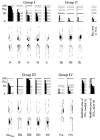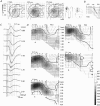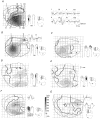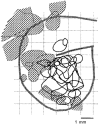Topographical organization of projections to cat motor cortex from nucleus interpositus anterior and forelimb skin
- PMID: 9852335
- PMCID: PMC2269074
- DOI: 10.1111/j.1469-7793.1999.551ae.x
Topographical organization of projections to cat motor cortex from nucleus interpositus anterior and forelimb skin
Abstract
1. The activation of the motor cortex from focal electrical stimulation of sites in the forelimb area of cerebellar nucleus interpositus anterior (NIA) was investigated in barbiturate-anaesthetized cats. Using a microelectrode, nuclear sites were identified by the cutaneous climbing fibre receptive fields of their afferent Purkinje cells. These cutaneous receptive fields can be identified by positive field potentials reflecting inhibition from Purkinje cells activated on natural stimulation of the skin. Thereafter, the sites were microstimulated and the evoked responses were systematically recorded over the cortical surface with a ball-tipped electrode. The topographical organization in the motor cortex of responses evoked by electrical stimulation of the forelimb skin was also analysed. 2. Generally, sites in the forelimb area of NIA projected to the lateral part of the anterior sigmoid gyrus (ASG). Sites in the hindlimb area of NIA also projected to lateral ASG and in addition to a more medial region. Sites in the face area of NIA, however, projected mainly to the middle part of the posterior sigmoid gyrus (PSG). 3. For sites in the forelimb area of NIA, the topographical organization and strength of the projections varied specifically with the cutaneous climbing fibre receptive field of the site. The largest cortical responses were evoked from sites with receptive fields on the distal or ventral skin of the forelimb. 4. Microelectrode recordings in the depth of the motor cortex revealed that responses evoked by cerebellar nuclear stimulation were due to an excitatory process in layer III. 5. Short latency surface responses evoked from the forelimb skin were found in the caudolateral part of the motor cortex. At gradually longer latencies, responses appeared in sequentially more rostromedial parts of the motor cortex. Since the responses displayed several temporal peaks that appeared in specific cortical regions for different areas of the forelimb skin, several somatotopic maps were seen. 6. The cerebellar and cutaneous projections activated mainly different cortical regions and had topographical organizations that apparently were constant between animals. Their patterns of activation may constitute a frame of reference for investigations of the functional organization of the motor cortex.
Figures









Similar articles
-
Topographical organization of the cerebellar cortical projection to nucleus interpositus anterior in the cat.J Physiol. 1994 Jan 15;474(2):245-60. doi: 10.1113/jphysiol.1994.sp020017. J Physiol. 1994. PMID: 8006811 Free PMC article.
-
Functional relation between corticonuclear input and movements evoked on microstimulation in cerebellar nucleus interpositus anterior in the cat.Exp Brain Res. 1995;106(3):365-76. doi: 10.1007/BF00231060. Exp Brain Res. 1995. PMID: 8983981
-
Cutaneous receptive fields and topography of mossy fibres and climbing fibres projecting to cat cerebellar C3 zone.J Physiol. 1998 Oct 1;512 ( Pt 1)(Pt 1):277-93. doi: 10.1111/j.1469-7793.1998.277bf.x. J Physiol. 1998. PMID: 9729638 Free PMC article.
-
The control of forelimb movements by intermediate cerebellum.Prog Brain Res. 1997;114:423-9. doi: 10.1016/s0079-6123(08)63378-6. Prog Brain Res. 1997. PMID: 9193158 Review.
-
Modulation of motor cortex excitability by sustained peripheral stimulation: the interaction between the motor cortex and the cerebellum.Cerebellum. 2005;4(2):90-6. doi: 10.1080/14734220410019084. Cerebellum. 2005. PMID: 16035190 Review.
Cited by
-
Local field potential sharp waves with diversified impact on cortical neuronal encoding of haptic input.Sci Rep. 2024 Jul 2;14(1):15243. doi: 10.1038/s41598-024-65200-3. Sci Rep. 2024. PMID: 38956102 Free PMC article.
-
Climbing fiber receptive fields-organizational and functional aspects and relationship to limb coordination.Cerebellum. 2015 Jun;14(3):360-3. doi: 10.1007/s12311-015-0647-y. Cerebellum. 2015. PMID: 25598536 Review.
-
On the neuronal circuitry mediating L-DOPA-induced dyskinesia.J Neural Transm (Vienna). 2018 Aug;125(8):1157-1169. doi: 10.1007/s00702-018-1886-0. Epub 2018 Apr 27. J Neural Transm (Vienna). 2018. PMID: 29704061 Free PMC article. Review.
-
Cerebellar Contribution to Preparatory Activity in Motor Neocortex.Neuron. 2019 Aug 7;103(3):506-519.e4. doi: 10.1016/j.neuron.2019.05.022. Epub 2019 Jun 11. Neuron. 2019. PMID: 31201123 Free PMC article.
-
An adaptive filter model of cerebellar zone C3 as a basis for safe limb control?J Physiol. 2013 Nov 15;591(22):5459-74. doi: 10.1113/jphysiol.2013.261545. Epub 2013 Jul 8. J Physiol. 2013. PMID: 23836690 Free PMC article. Review.
References
-
- Andersson G. Regional differences in evoked response latencies in the cat motor cortex (area 4γ) Acta Physiologica Scandinavica. 1986;127:395–405. - PubMed
-
- Andersson G. Cortico-cortical mediation of short-latency (lemniscal) sensory input to the motor cortex in deeply pentobarbitone anaesthetized cats. Acta Physiologica Scandinavica. 1995;153:381–392. - PubMed
-
- Armand J. Topical versus diffuse organization of the corticospinal tract in the cat. Journal de Physiologie. 1978;74:227–230. - PubMed
-
- Armand J, Kuypers H G J M. Cells of origin of crossed and uncrossed corticospinal fibres in the cat. A quantitative horseradish peroxidase study. Experimental Brain Research. 1980;40:23–34. - PubMed
-
- Asanuma H, Arnold A, Zarzecki P. Further study on the excitation of pyramidal tract cells by intracortical microstimulation. Experimental Brain Research. 1976;26:443–461. - PubMed
Publication types
MeSH terms
LinkOut - more resources
Full Text Sources
Miscellaneous

